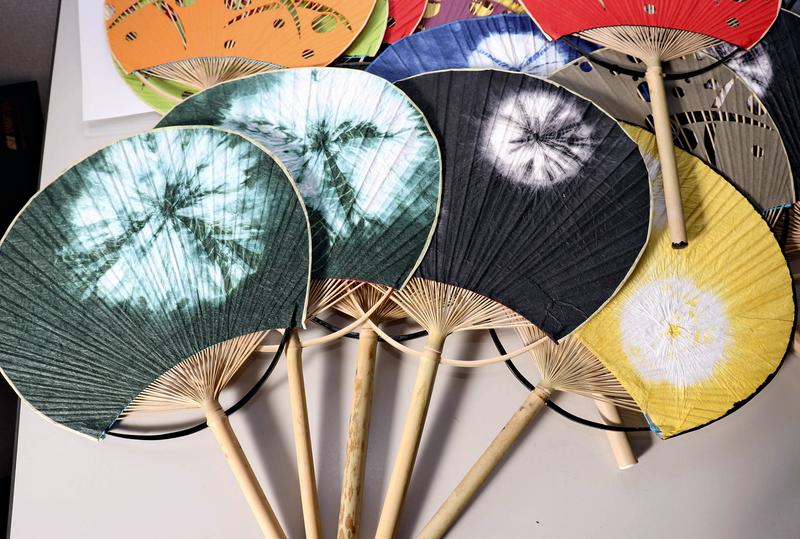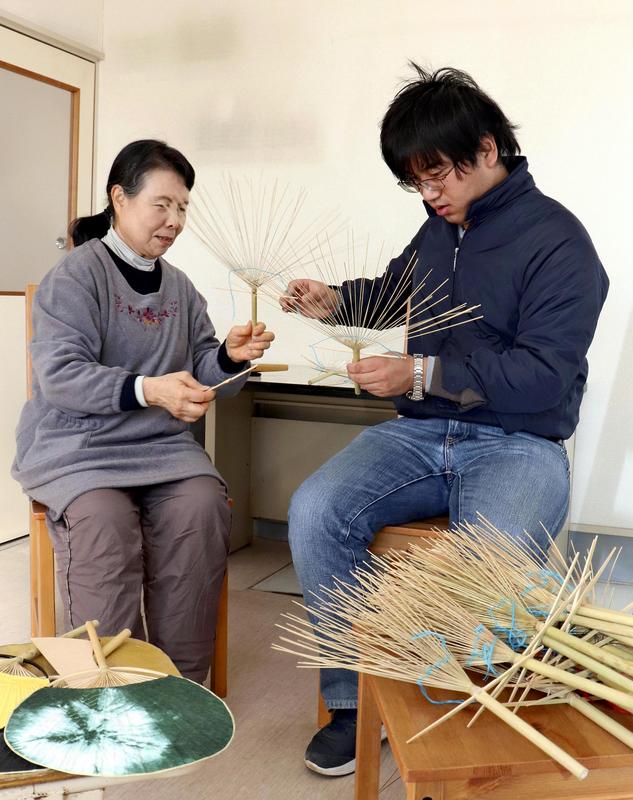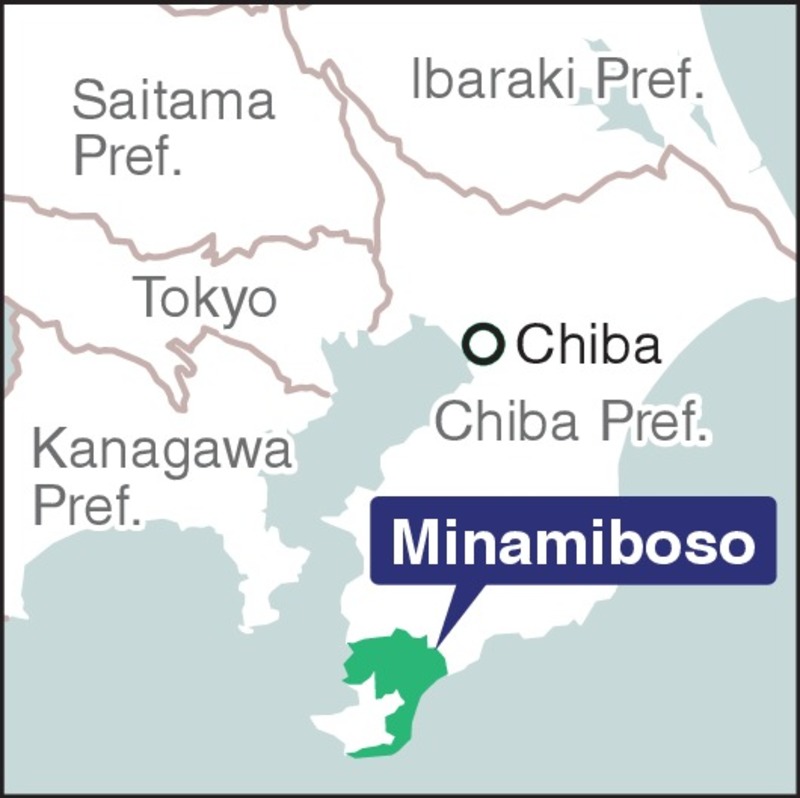
MINAMIBOSO, Chiba -- Early last December, I visited a work facility in the Tomiura area of Minamiboso, Chiba Prefecture, where I observed disabled people and others making Boshu Uchiwa paper fans.
Mitsue Ota, a 67-year-old certified traditional craftswoman, nodded with satisfaction as she watched Hideki Awata, 26, skillfully working with his hands.
Boshu Uchiwa is one of the three major uchiwa fans in Japan, along with Kyo Uchiwa from Kyoto Prefecture and Marugame Uchiwa from Kagawa Prefecture. The Chiba version is made from medake simon bamboo, which grows throughout the prefecture's Minamiboso area.

One of the fan's features is its round-shaped handle. The tip of the handle is finely split, forming the "frame" of the fan. While Boshu Uchiwa is a seasonal summer item, preparations for its production, such as cutting down bamboo, begin in winter.
Boshu Uchiwa originates from Edo Uchiwa. After the 1923 Great Kanto Earthquake, wholesalers and craftsmen migrated to the southern Boso Peninsula, leading to large-scale production of uchiwa in the area.
According to the Minamiboso city government, peak production lasted from the late Taisho era (1912-1926) through the early Showa era (1926-1989), during which seven to eight million fans were made annually. However, annual production has since declined to about 20,000 due to the growing use of electric fans and air conditioners.

Today, only five factories produce Boshu Uchiwa, and one of the two nationally certified traditional craftsmen who supported production of the fans died in 2017. Ota is the sole remaining Boshu Uchiwa certified traditional craftswoman, and training her successors has become an issue. Amid these circumstances, disabled people are expected to support the production of Boshu Uchiwa.
Awata, who suffers from integration disorder syndrome and attended a welfare workshop, began to learn how to make the fan in September 2016.
There are 21 steps in the Boshu Uchiwa production process, and it is said that 10 years are required to learn the necessary skills. However, the diligent Awata has rapidly improved his abilities. Ota favorably views his work, noting, "His fans are as good as commercial fans."
Naohiro Yamamoto, 50, chairman of a group called "Boshu Uchiwa Denfuku Renkei no Kai," connected Ota with disabled people. Yamamoto had a strong interest in helping people with disabilities find work when they become adults, as his nephew has autism.
As there are agricultural-welfare cooperatives that help disabled people thrive in agricultural occupations, Yamamoto thought a similar framework could be applied to traditional crafts. He quit his job at a company and began his new activities, through which he brings together traditional crafts and welfare facilities.
While looking for nationally designated traditional crafts in Chiba Prefecture, Yamamoto learned about Boshu Uchiwa. He visited Ota and asked her to teach disabled people how to make the fans, and also asked local welfare work facilities to let their members join his project. As a result, Ota began teaching fan-making techniques once a week.
At present, four disabled people from the Tomiura work facility, including Awata, meet with Ota and learn how to make fans with three others who are not disabled.
"I want to become a nationally certified traditional craftsman," Awata said.
"What they're doing differs from the light work at welfare work facilities, and they can take pride in what they do," Yamamoto emphatically added.
Their efforts are bearing fruit. After heavy rains battered western Japan last July, about 60 Boshu Uchiwa fans were distributed to disaster victims. Disabled craftsmen also made tie-dyed paper that non-disabled workers used to make Boshu Uchiwa in the summer of 2018. They sold the fans at a local michi-no-eki roadside facility, with about 20 to 30 fans selling per month.
In November 2018, they participated in the campus festival for Matsudo, Chiba Prefecture-based Seitoku University, which has a partnership with the Minamiboso city government. Members of Denfuku Renkei no Kai made fans decorated with pictures and patterns designed by the students and others, and exhibited them at the festival. At their booth, fans made by non-disabled members were also sold.
The Boshu Uchiwa fanmakers' association holds a beginners' course on how to make the fans from autumn through winter each year. Those who complete the course participate in Denfuku Renkei no Kai. Awata enrolled in the course to further improve his skills.
Further initiatives involving local people will continue in the future to protect a traditional craft that has been passed on for generations.
Kyoto's support system
Expectations for the participation of disabled people are rising in Kyoto's traditional craft circles, which faces a serious shortage of people to inherit crafts.
In fiscal 2011, the Kyoto city government began to subsidize companies and others who are highly motivated to employ disabled people, covering relevant costs such as the expenses for dispatching advisers to support business projects.
In March 2018, a long-established Kyo-Kanoko Shibori dyed fabric manufacturer hired a person with a developmental disorder. A person with mental disorders likewise works as a painter at a well-established Japanese candle shop. In fiscal 2018, Kyoto city created a scheme for developing successors to craftsmen that connects traditional craftmakers with disabled people and welfare facilities.
"The world of traditional crafts can offer work environments where disabled people can be confident and proud of themselves," said a municipal government official in charge.
-- Minamiboso, Chiba Pref.
Located in the southern Boso Peninsula in Chiba Prefecture, the city spreads as if it surrounds Tateyama in the same prefecture. Minamiboso was created on March 20, 2006, through the merger of six towns and a village. As of Jan. 1 this year, it had a population of 38,401.
The city is blessed with seafood resources, while the mild climate enables cultivation of vegetables, fruits and flowers. It is home to the Nojimasaki lighthouse on the southern tip of the peninsula and the Wada fishing port that serves as a base for coastal whaling.
The former town of Tomiura, which was incorporated into Minamiboso, boasts the country's largest loquat production. The city is also the site of the Chiba prefectural Mineoka dairy cattle experiment station, designated by the prefecture as a historical site where Japanese dairy farming originated.
Read more from The Japan News at https://japannews.yomiuri.co.jp/







